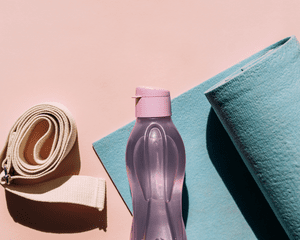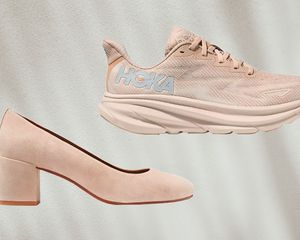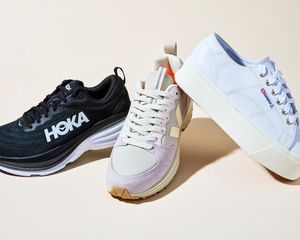:max_bytes(150000):strip_icc()/GettyImages-1148443194-c49a0f7fc06140be80370a9d791cb170.jpg)
Getty Images / Leo Patrizi
If you’ve seen enough inspirational photos on your Instagram feed of friends completing marathons, or are bored with your spinning routine, you might find yourself wondering if it’s time to hop on the marathon bandwagon yourself. After all, running seems like a positive "trend" to jump on, since it gets your heart pumping, your muscles moving, and your lungs breathing in the fresh outdoor air. However, pounding the pavement (or trail, track, or treadmill) for so many miles has us wondering if there are any serious bodily risks involved.
To get to the bottom of the potential risks and benefits of marathon training, we turned to two running experts.
Meet the Expert
Jonathan Cane is an exercise physiologist and certified running coach. He has been coaching marathon runners for over 30 years, and is the author of Triathlon Anatomy.
John Rowley is a certified personal trainer, the ISSA director of wellness, the founder of UX3 Nutrition, and the best-selling author of The Positive Power of Fitness.
Let’s get the bad news out of the way first. While Cane and Rowley shared that there are definite benefits to training for and running marathons, there are a handful of risks and consequences as well. But before you nix the idea of putting “running a marathon” on your bucket list, stick with us. Our experts have some great advice on mitigating the potential risks, below.
The Potential Risks:
:max_bytes(150000):strip_icc()/GettyImages-1341854188-03c44f914a6e49af938b70a7c1e91380.jpg)
MoMo Productions / Getty Images
Musculoskeletal Injuries
According to Rowley, by far the most common downside of logging so many miles is that it causes a significant amount of wear and tear on joints and muscles because of the frequent and heavy impact. A research review of risk factors for running injuries found evidence suggesting a correlation between a history of previous injuries and a higher risk of incurring new ones from running. Runners who previously suffered overuse injuries should be sure to seek assessment by a physical therapist to address and correct whatever factors led to that injury—be it improper footwear, overly aggressive training, muscle imbalances, or nutritional deficiencies. Failing to remedy the root cause is a recipe for a recurrence.
Even though running injuries are common during marathon training, there are several steps you should take to minimize your risk. The first is to train smartly. Runners who do too much too soon, overdo it in general, or train too sporadically are all at increased risk for musculoskeletal injuries. The body needs time to adapt to training, and recovery and rest are also critical for tissue repair. Make sure you work with a coach or get a proper training plan.
Secondly, make sure you warm up for your training runs and races. "Instead of starting in a full-out sprint, give yourself some time to gain better range of motion and momentum—once you feel your body is acclimated to a comfortable speed, you can then start to push yourself a little more to avoid injury,” Rowley says. He also urges all runners to stretch. "You're less likely to encounter injury while running if you've prepped your muscles with a good stretch."
It is also important to make sure your shoes fit properly and are changed about every 350-500 miles to ensure they still provide the support and cushioning you need.
Lastly, Rowley recommends eating a diet full of lean protein, complex carbohydrates, and fresh greens, as well as drinking plenty of water. It’s also important to get enough calories to help your tissues rebuild.
Muscle Soreness
To the uninitiated, it might seem like marathoners like their lingo almost as much as the post-race brunch. After all, it shows you’re part of the special 26.2-mile club. If you’re thinking of becoming a card-carrying member, one of the terms you should be familiar with is DOMS, which is an acronym that stands for Delayed Onset Muscle Soreness. While popular thought used to be that DOMS was the result of lactic acid in the muscles, this is not true (lactic acid is metabolized and removed).
“In most cases, DOMS is due to microscopic tearing of muscle tissue. It's usually worse after hard runs, and especially so after downhill running,” explains Cane. “Being attentive to post-run nutrition can help decrease the effect or duration of the soreness, so be sure to get some protein, complemented by carbohydrate shortly after the run.”
Byrdie Tip
“If you're having trouble differentiating between ‘normal’ muscle soreness and injury, keep in mind that DOMS usually sets in the day after a run, gets worse the second day, and [then] starts to ease up,” says Cane. “If your pain is not following that pattern, [or] is sharp or radiating, it may be indicative of something more substantial.”
Losing a Toenail (Or Two)
You might need to put your favorite pedicurist on speed dial once you start marathon training. Though certainly the gravity of black toenails or even toenail loss pales in comparison to more severe injuries, toenail maladies are so ubiquitous among marathon runners that there are memes declaring them a rite of passage.
“To a certain extent, it's just the nature of the beast; your toes contact the inside of your shoe thousands (if not tens of thousands) of times in each run,” explains Cane. “Even a subtle rub adds up when multiplied over days, weeks, months. That repeated contact can lead to blood forming under the nail, which in turn can lead to the nail falling off.”
The good news is that while some degree of microtrauma may be inevitable, you can reduce your risk, should you decide you’re perfectly fine skipping this rite of passage. “First, cut those toenails short. The shorter they are, the less contact there will be with the shoe,” advises Cane. “Second, make sure your shoes fit properly. Sure, some of this is inevitable, but if it's happening often, it's likely that the shoes don't fit properly. Along those same lines, experiment with different sock thicknesses.”
Kidney Damage
Most people don't immediately think of kidney damage when they think of the common risks of marathon running. However, according to research conducted at the Yale University School of Medicine, 82 percent of marathoners experienced acute kidney injury (AKI). AKI affects the kidneys' ability to filter waste from the blood and balance fluids and electrolytes. Fortunately, this condition typically resolves within 48 hours with proper rehydration. A subsequent study found that runners who experienced AKI during a marathon were particularly heavy sweaters, losing approximately four liters during the race—two liters more than marathoners without AKI. According to Cane, with proper race hydration, including the ever-important electrolytes such as sodium and potassium, it should be possible for all runners to avoid AKI.
Weakened Immune System
”After particularly challenging runs, your immune system is suppressed, and you're more susceptible to illness,” says Cane. “That's certainly not a reason to avoid running, but it is justification to avoid hard efforts if you're already feeling compromised or might be exposed to contagions.” Fortunately, if you listen to your body and skip your run when you feel a sore throat coming on or feel worn down, your immune system should be able to fend off any illnesses during your marathon training. After all, getting regular exercise has been shown to correlate to a more robust immune system. Just don’t overdo it.
The Potential Rewards:
:max_bytes(150000):strip_icc()/GettyImages-1298101246-5c51da6112814851acbd8c9fdd16b9fe.jpg)
Oscar Wong / Getty Images
Marathoning also has many upsides, which is probably why so many people around the world toe the starting line for a marathon every year. “Running, and exercise in general, has countless health benefits that go well beyond being able to run faster,” notes Cane. Let’s dig into some of these benefits.
Boosting Cardiovascular Health
Marathon running has been shown to improve markers of cardiovascular health. For example, research has shown that it can decrease blood pressure and resting heart rate. It may also reverse the aortic stiffening process that naturally occurs with aging. And because aortic stiffening is associated with increased risk of cardiovascular events, this means running marathons may keep your ticker healthily ticking along.
Produces Mood-Lifting Endorphins
If you've heard of the notorious "runner's high," you are likely aware that running for long periods of time can bring on feelings of euphoria. This happy feeling is claimed to be the result of endorphins, the natural, feel-good hormones produced by the body. However, Cane says "the so-called 'runner's high' is as elusive as a yeti for most runners."
Improves Mental Health
Beyond just a short-term, mood-boosting power, training for and completing a marathon may help improve your mental health overall. Cane notes that running can build a sense of confidence and self-efficacy, and help alleviate depression and anxiety.
No Equipment Required
Besides needing a good pair of shoes (though some runners still swear that barefoot is the way to go), running doesn’t require a lot of special, expensive equipment. Sure, there are all sorts of accessories, cute clothes, and training gadgets you can buy if you have the desire and means, but overall, running is a relatively affordable hobby. Marathon entry fees can cost upwards of $200 for some of the most popular big-city races, but you can save money by opting for a smaller, local race and registering well in advance.
The Final Takeaway
:max_bytes(150000):strip_icc()/GettyImages-656983165-deee415d51db44d887fdb0dcbf2b1039.jpg)
Tony Anderson / Getty Images
Although it’s undoubtedly an impressive feat, running a marathon is actually possible for most people. There are even avenues for runners with physical impairments, such as Achilles International for athletes with disabilities and Prosthetic Running for runners with limb loss. You also don’t have to have to look a certain way, and it’s never too late to start.
“In contrast with just about any other sport, marathoning encourages participation and allows everyone to compete on the same playing field,” remarks Cane. “In the NYC Marathon, 50,000 runners line up and cover the exact same 26.2 miles, whether their goal is to come home with a laurel wreath and a big paycheck, or simply to finish. No doubt running a marathon requires hard work and dedication and is a huge undertaking, but with consistent and diligent work, it's an achievable goal—regardless of age, size, or just about any other variable.”




